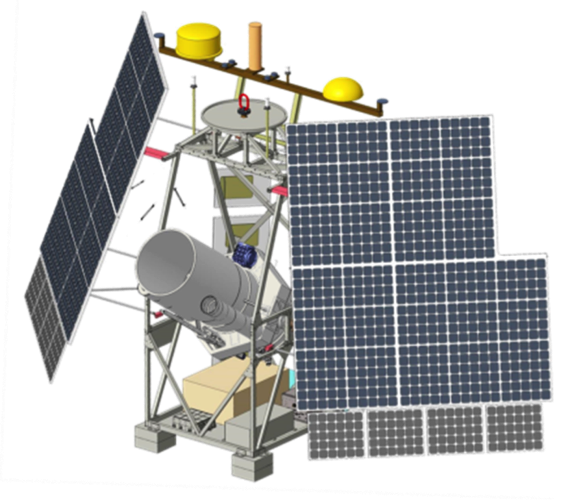Eerste volledige studie levenscyclus van sterren
NASA heeft een missie geselecteerd die straling vanuit het interstellair medium (tussen sterren) gaat meten met Nederlandse ver-infrarood camera’s. De ballontelescoopmissie GUSTO geeft een eerste volledige studie van alle fases van de levenscyclus van sterren: van moleculaire wolken, via de geboorte en evolutie van sterren tot de gaswolken van stervende sterren, terug naar het begin van de cyclus. SRON en de TU Delft ontwikkelen de belangrijkste detector technologie.

English follows Dutch
GUSTO staat voor Galactic/Extragalactic ULDB Spectroscopic Terahertz Observatory. De missie bestaat uit een telescoop van een meter diameter met drie observatie-instrumenten, die wordt gedragen door een ballon: een Ultra-long Duration Balloon (ULDB). GUSTO gaat 40 kilometer boven Antarctica vliegen, op de grens met de ruimte. Afgelopen december werd GUSTO’s voorganger STO2 gelanceerd als verkenner, waarmee de werking van de technologie van SRON en TU Delft voor GUSTO werd gedemonstreerd.
SRON en de TU Delft dragen bij met hete elektron bolometer camera’s voor drie verschillende ‘kleuren’ ver-infrarood, een lokale oscillator en een vernieuwende fase tralie, die de detectoren helpt om de precieze ‘kleur’ te bepalen (de precieze ver-infrarood-golflengte, uitgedrukt in Terahertz frequentie).
GUSTO meet emissielijnen van koolstof, zuurstof en stikstof. De unieke en vernieuwende combinatie van data helpt complexe vragen over het interstellaire medium te beantwoorden en grote delen van de Melkweg en de Grote Magelhaense wolk in kaart te brengen.
“NASA heeft met het Explorers Program een traditie in het lanceren van onderzoeksmissies met nieuwe en unieke waarneemmogelijkheden. GUSTO zet die voort”, zegt Paul Hertz, astrofysisch divisiedirecteur in NASA’s hoofddirectie wetenschappelijke missies in Washington.
NASA vindt dat GUSTO, uit acht missievoorstellen waarvan er twee nader bestudeerd werden, de beste potentie heeft voor excellente wetenschappelijke resultaten met een haalbaar missievoorstel.
De lancering van GUSTO staat voorlopig gepland voor 2021 vanaf McMurdo op Antarctica. De vlucht zal naar verwachting 100 tot 170 dagen duren, afhankelijk van de weersomstandigheden. De missie kost ongeveer $40 miljoen, inclusief de ballonlancering en operationele kosten en data-analyse.
De Universiteit van Arizona zorgt voor de telescoop en instrumenten met technologie van SRON, TU Delft, NASA’s Jet Propulsion Laboratory, het Massachusetts Institute of Technology, en de Arizona State University. The Johns Hopkins University Applied Physics Laboratory ontwikkelt de gondel waarop de instrumenten worden gemonteerd.
Eerste onderzoeker voor de missie is Christopher Walker van de Universiteit van Arizona. Jian-Rong Gao (SRON & TU Delft) leidt het project in Nederland. Floris van der Tak (SRON & Rijksuniversiteit Groningen) en Xander Tielens (Universiteit Leiden) maken deel uit van het wetenschappelijke team.
More information: Renske van den Berg, 06 2304 8229, r.g.m.van.den.berg at sron.nl
—–
Dutch ‘cameras’ on NASA Science Mission
‘First complete study of all phases of the stellar life cycle’
NASA has selected a science mission that will measure emissions from cosmic material between stars (the interstellar medium) with Dutch Far-Infrared (FIR) ‘cameras’. The balloon telescope mission GUSTO will provide the first complete study of all phases of the stellar life cycle, from the formation of molecular clouds, through star birth and evolution, to the formation of gas clouds and the re-initiation of the cycle. SRON Netherlands Institute for Space Research and the TU Delft develop the key detector technologies.
GUSTO stands for Galactic/Extragalactic ULDB Spectroscopic Terahertz Observatory. The observatory consists of a telescope of one meter in diameter, and three observation instruments carried by an Ultra-long Duration Balloon (ULDB). GUSTO will fly on an altitude of 40 km above Antarctica, at the edge of space. SRON and TU Delft contribute hot electron bolometer multi-pixel camera’s, operating at three Terahertz frequencies, and also a local oscillator and a novel phase grating that helps the detectors determine the exact color of the light. Last December GUSTO’s precursor STO2 was launched as a pathfinder, demonstrating the Dutch key detector technologies from SRON and TU Delft.
GUSTO detects carbon, oxygen and nitrogen emission lines. The unique and novel combination of data will provide information needed to untangle the complexities of the interstellar medium, and map out large sections of our Milky Way galaxy and the nearby galaxy known as the Large Magellanic Cloud.
“NASA has a great history of launching observatories in the Astrophysics Explorers Program with new and unique observational capabilities. GUSTO continues that tradition”, says Paul Hertz, astrophysics division director in NASA’s Science Mission Directorate in Washington.
NASA determined that out of eight proposals of which two were further studied since 2014, GUSTO has the best potential for excellent science return with a feasible development plan.
The GUSTO mission is targeted for launch in 2021 from McMurdo, Antarctica, and is expected to stay in the air between 100 to 170 days, depending on weather conditions. It will cost approximately $40 million, including the balloon launch funding and the cost of post-launch operations and data analysis.
The University of Arizona in Tucson will provide the actual GUSTO telescope and instruments, with technology from SRON, TU Delft, NASA’s Jet Propulsion Laboratory in Pasadena, California, the Massachusetts Institute of Technology in Cambridge, and the Arizona State University in Tempe. The Johns Hopkins University Applied Physics Laboratory in Laurel, Maryland, provides the mission operations, and the gondola where the instruments are mounted.
The principal investigator of the mission is Christopher Walker from the University of Arizona. Jian-Rong Gao (SRON & TU Delft) will lead the project in the Netherlands. Floris van der Tak (SRON & University Groningen) and Xander Tielens (University Leiden) will contribute to the science team.
More information: Renske van den Berg, 06 2304 8229, r.g.m.van.den.berg at sron.nl


